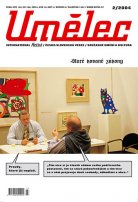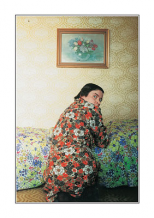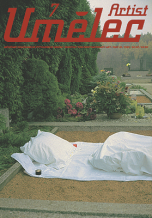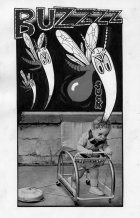| Zeitschrift Umělec 2004/2 >> Capturing Personal Identity On Miodrag Krkobabić’s (Fake) Identities | Übersicht aller Ausgaben | ||||||||||||
|
|||||||||||||
Capturing Personal Identity On Miodrag Krkobabić’s (Fake) IdentitiesZeitschrift Umělec 2004/201.02.2004 Zoran Erić | en cs |
|||||||||||||
|
Skyscraper story
In his first video, 6=36, Miodrag Krkobabić employed a narrative mode and documentary approach to tell the story about the relationships of his friends from childhood to each other and to himself. Born in the same building and nearly the same age, they all meet again after a long time to tell each about each other’s personality. After years growing up with each other, Krkobabić pursued an artistic career, graduating from the Faculty of Fine Arts. When he returned, he saw that his friends maintained the same lifestyle as before, and that he was the only one to have left the old neighborhood. Krkobabić’s method of investigation in the video is similar to display behavior in the sense used by Erving Gofman in his studies on the genesis of identity — its definitions shifting from individual-psychological, via micro-sociological to a cultural level. For Gofman it is important that the relationships of others towards an individual are mediated by the consciousness that this individual has on the consciousness the others have on him.1 For Krkobabić the question about his relationships with his friends was: “do we actually know each other or do we know the image that we made of ourselves or of the people we know?”2 Krkobabić was dealing principally with the problem of our incapability of catching a personal identity which is always changing and relational. This claim could be supported by the thesis of Ernesto Laclau that identity cannot be understood as something fixed; it is not an artefact, it should always be a process. Laclau develops this argument further stressing the necessary incompleteness of identity formation. As he puts it, “the field of social identities is not one of full identities but of their ultimate failure to be constituted.”3 He argues that all objects of scrutiny in the social sciences are incompletely constituted because of their location within a field of difference from one another. What distinguishes them is a particular historicity that provides the forces of dislocation, which always block the formation of complete objects. Consequently, any articulation of identity is just temporarily complete, it is always in part constituted by the forces that oppose it (the constitutive outside), and continually contingent upon surviving the contradictions that it subsumes (forces of dislocation).4 In the case of the video of Krkobabić this line of argument could be expressed with his statement that the “story of 6 men becomes a story of 36 identities”5. From collective to personal identity The social reality of Yugoslavia in the nineties was of a country that had lost its collective identity, suffered from isolation from the rest of the world and endured regional wars. In addition, the system of values was turned upside down, ethnonationalism, populism, xenophobia and hate speech shaped the public sphere, and it became extremely brutal for the citizens and especially for the younger generation. Krkobabić’s stories speak of these “less fortunate” friends who worked in the black market, smuggling and small time “business.” The problem of identity and identification therefore occurred as of on the key social problems, and it was highly abused by the political oligarchy to seduce young generations with the nationalistic ideological matrix that had even worse effect on them. These traumatic social conditions effected the Serbian artists, but left them mostly isolated, withdrawn and without immediate reaction. It came with delay by the mid nineties when some of the most prominent Serbian artists started to reflect the problem of loss of identity and the confusion of citizens that couldn’t find their response to the reality confronting them. Among the first paradigmatic art works that was addressing the issue of identity and identification were the video installations by Milica Tomić – XY Ungeloest in 1997 and I am Milica Tomić in 1999. While the first work was highly politically motivated where the artists identified with the Albanian victims killed in the demonstrations in Kosovo, the second work was dealing with the production of national identity in Serbia and its consequences for her personal identification process. It may be said that this work opened up the discourse of identity politics and identity building on the Serbian art scene, and that several younger artists, Miodrag Krkobabić being one of the most active, took upon this problem in all of its ramifications. This generation of artists entered the scene by the end of the nineties introducing a very strong conceptual approach from the beginning of their work, and started using various strategies, always in the most appropriate media, to address different aspects of the process of identification and acquiring of social, religious, and above all, professional – artistic identity. On the level of global art ground the issue of identity politics is often explored by artists that are emphasizing their local or ethnic cultural identities. The particularities of these cultures and their local ‘folklore’ is becoming more and more the focal point for many artists whose work came to be recognized and represented at major international exhibitions that have cherished this tendency for years, Documenta 11 being its culmination. In comparison to that tendency artists like Krkobabić are pursuing another kind of relation to the process of identity formation. His works belong to the strategy of personal but very analytical investigation and reading of the actual issue of ones identity, its constant shifts and alterations, and the incapacity of capturing it. Fake ID In the series of works that followed, Krkobabić started to use the format of personal identification documents and the police standard in documenting individual identity with photos, personal numbers, etc. This technique was historically developed by the reforms of the judiciary system in establishing identity by Alphonse Bertillon6. He established a method known as anthropometry that incorporates a series of refined bodily measurements, physical description and what is most important for the future look of ID documents – photographs. From the sphere of criminology photographic identification was gradually extended to cover the entire population. This pretext is becoming very important in works like Fake Identity (billboards), Portrait of an Unknown Man with a Beard (digital photography), and Personal? ID? Card (digital video installation) where Krkobabić was elaborating further on the issue of impossibility of catching the definite identity. This combination of identification techniques with the analysis of the process of personal identity building could be exemplified with the project Portrait of an Unknown Man with a Beard. Krkobabić is here using the form of police photography, en face and two profiles, but mixing the eye line of friends and colleagues with his own face and marking the photos with the personal ID number of the one whose identity he is “borrowing”. His own process of identification was interwoven with the same process of the members of his family, friends and his colleagues from the art-world. These encounters in life and professional career are influencing and shaping the personal identity of the artists, always adding something to it, and setting track for his identity formation process that is eventually never going to be fully concluded and determined. Notes: 1. As quoted in Branimir Stojkovic, Identitet i komunikacija, Cigoja štampa, Belgrade, 2002 2. Unpublished artist’s statement. 3. As quoted in Michael Keith and Steve Pile Ed. Place and the Politics of Identity, Routledge, London New York, 1996. (p. 29) 4. Ibid (pp.25-29) 5. Unpublished artist’s statement. 6. Philippe Comar, Made-to-measure Identity in Identity and Alterity, the catalogue of the 46th Venice Biennial, Marsilio, Venice 1995
01.02.2004
Empfohlene Artikel
|
|||||||||||||
|
04.02.2020 10:17
Letošní 50. ročník Art Basel přilákal celkem 93 000 návštěvníků a sběratelů z 80 zemí světa. 290 prémiových galerií představilo umělecká díla od počátku 20. století až po současnost. Hlavní sektor přehlídky, tradičně v prvním patře výstavního prostoru, představil 232 předních galerií z celého světa nabízející umění nejvyšší kvality. Veletrh ukázal vzestupný trend prodeje prostřednictvím galerií jak soukromým sbírkám, tak i institucím. Kromě hlavního veletrhu stály za návštěvu i ty přidružené: Volta, Liste a Photo Basel, k tomu doprovodné programy a výstavy v místních institucích, které kvalitou daleko přesahují hranice města tj. Kunsthalle Basel, Kunstmuseum, Tinguely muzeum nebo Fondation Beyeler.
|





































 Potsdamer Str. 161 | Neu Divus in Zwitschermaschine, galerie und buchhandlug in Berlin! | Mit U2 nach Bülowstraße
Potsdamer Str. 161 | Neu Divus in Zwitschermaschine, galerie und buchhandlug in Berlin! | Mit U2 nach Bülowstraße
Kommentar
Der Artikel ist bisher nicht kommentiert wordenNeuen Kommentar einfügen